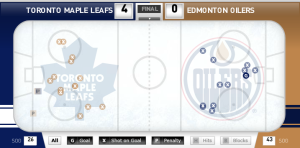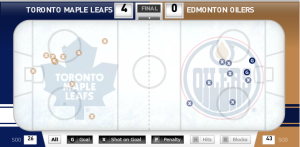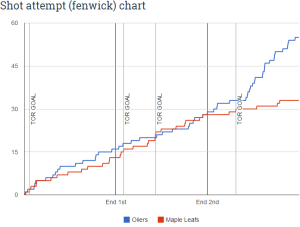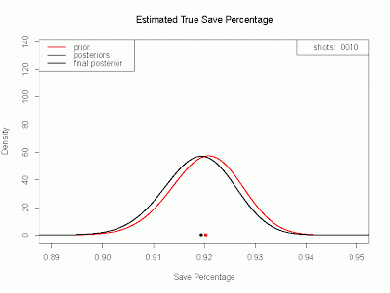Since my last post, the Toronto Maple Leafs have gone 3-3-0; they have scored 17 goals, given 14, and have accumulated an additional six points to tighten their stranglehold of the top of the Eastern Conference. Even though the Leafs are winning games and are atop of the conference, the most impressive detail has been the goaltending – the Leafs have given up 30 goals in 13 games, which brings them to a surprising 2.31 GAA – good for 6th overall in the NHL.
One thing I really enjoy about the hockey blogosphere is that I get to read Leafs-centric posts like Anthony Petrielli’s Monday Notebooks that explores the past week of hockey that the Leafs have played. Petrielli pours a lot of his own time into studying the nuances of hockey and applying that deep well of knowledge into his weekly breakdown of the Leafs. Obviously, his work is a tremendous read, often pointing out seemingly minor details that have had a huge impact on game.
Petrielli’s methodology is kind of what I would like to do here with this blog. I don’t consider myself to have the same understanding of hockey that he does, but I do think I can try to explore some of the other nuances of the game – such as analytics. The thing is, analytics to some readers is considered a dirty word; a clinical perversion of the chaotic state of hockey. This kind of mindset is a little unfair – the state of hockey analytics may not be very strong just yet, but it is getting there.
Today, I am going to talk about the relationship between shots and score effects and post some stuff I have been monitoring.
James Reimer & Jonathan Bernier
Note: This section is a bit disjointed as I continued to write, so if you need clarification, post a comment and I will try my best to unravel the mess that are my thoughts at the moment.
One thing I have been keeping a close eye on is to see which goaltender seems to positively influence possession. When the Leafs acquired Bernier, I posited that the Leafs wanted a goaltender who could handle the puck. If it is true that the Leafs wanted a puck-handler who could shut down the forecheck quickly, then they seem to have picked a pretty decent goaltender to trade for.
With that said, Bernier has a Corsi For percentage of 45.4% to Reimer’s 40.2% in 5 on 5 close situations of two goals or less. If you remove blocked shots, the Fenwick For percentage favours Bernier 44% to 38.2% in the same even strength situations. It has been said that goaltenders cannot influence possession in a statistically relevant way, but I’m not too sure that is the case. Last season, Ben Scrivens and Reimer had a CF% of 44.6% and 42.8% respectively. Perhaps it is my own takeaway, but it seems to show that Reimer does seem to negatively impact the Leafs possession woes.
The more I think about it, the team defense hasn’t caught up to the development of the Leafs goaltending; basically, the team defense is light-years behind the stellar goaltending we are watching from Reimer and Bernier. So as a whole, the Leafs’ inconsistent play is reflective the non-linear team development. If that is the case, once the defense starts to gel, we should start seeing better shot suppression.
We’re only 61 games into the reverse Corsi that the Leafs bring to the ice, but it’s just enough to get a glimpse of the team’s seeming inability to hold onto the puck long enough to put a dent into someone’s spreadsheet. Someone recently mentioned that the Leafs scored the most first goals in the NHL last season – which turned out to be true to a tune of 32 games with the Leafs having scored first.
When you apply the score effect of two goals lead or less, the game slowly begins to open up. If you think about it, the application of score effects are important because we can see that Scrivens had a -5 goal differential last season compared to +12 from Reimer – the quality of goaltending is important here. This brings me to my next point: the Game 7 collapse against Boston highlighted the team’s inexperience of shutting down a desperate team. The twist to having led the league in goals scored first is that the Leafs only won 19 of those games. They simply don’t have a lot of experience with handling pressure.
This is partially why I am convinced that it’s not the system, but the team defense – the inexperience is constantly on display. A missed assignment here, a missed assignment there – and the shots add up. If anything, I think the system Randy Carlyle has implemented is protecting the missed assignments because it assumes that there will be a lot of mistakes made. That somewhat explains why the defense collapses when a shot gets through to the net.
Obviously, a goal is the end result of preceding events leading up to it, so the differential not an analysis really fleshed out – but the Leafs are a quick strike team that feasts on turnovers, open-ice, and transition play. So while goal-differential is a pretty one-dimensional analysis, it is another way of trying to figure out the perspective of management, so I think it is a pretty important detail. The refrain from Carlyle is a pretty good way of putting it: “We just need them(Reimer and Bernier) to give us a chance to win.”
Of note: QuantHockey has the Leafs as the youngest team in the NHL. That’s not going to change significantly with Bozak, Kulemin, and Fraser eventually making their way back to the line-up. In addition, the Leafs defense is currently listed as the sixth youngest.
Location, Location, Location
A growing consensus among social media and analytics is that the Leafs don’t really keep shots to the outside – on average. I think this is a misrepresentation of the system the Leafs have in place because they generally keep shots to the outside for the most part until the score effects take place (Note: This is an observation).
If you look at the shots the Leafs faced at even strength last season, they led the league in shots allowed from outside 20 feet, but were generally league average in shots allowed inside 20 feet. I explored this awhile back because I didn’t think analytics were representing the Leafs’ possession issues in an impartial or fair way. Obviously, 20 feet more or less is arbitrary, but it did clear up the shot location picture quite a bit. I may go back at some point to look at analyzing shots outside 30 feet and inside 30 feet though.
One thing about score effects: they are a pretty accurate way of looking at how teams perform with a lead over long period of time. I thought last night’s game against Edmonton highlighted how important it is to monitor score effects because they are generally reflective of how the game opens up league-wide. Last night’s game also highlighted the shot location picture a bit. The Leafs managed to shut down the Edmonton Oilers, but I’m not sure that they did it with authority. This goes back to the shutdown issue I brought up with regards to the team defense. Check out the three periods.
If you look at the first two periods, the Oilers tried to get shots through on Reimer’s glove side (when are teams going to learn that he actually has a pretty decent glove hand?). While the Leafs struggled a bit with keeping shots outside last night, Reimer was up to the task. The Oilers are a highly skilled team, so it was no surprise that they were able to generate scoring chances. After two periods, Jonathan Willis noted that the scoring chances were even at 11 for both teams. But the important distinction is this: the Leafs were suppressing shots pretty well. Through one and a half periods, they gave up 12 shots – that’s 24 shots over the course of a full game.
In addition, the Leafs and Oilers were pretty much neck to neck at Fenwick For percentage throughout the game. This is to be expected because most teams are generally around the 48-52% FF% range. But once the Leafs scored their third goal, you kind of knew the Oilers would get desperate. ExtraSkater has a nice highlight of the score effects after the fourth goal below.
I think the Leafs are managed in a way that they begin to settle too early once they are up a goal. Perhaps someone with more analytical resources can take a look because once the Leafs are up a goal, they generally start to sit back more often than not.
Here are the shot locations charts from the last six games: Carolina vs. Toronto, Chicago vs. Toronto, Anaheim vs. Toronto, Columbus vs. Toronto, Pittsburgh vs. Toronto, Edmonton vs. Toronto
Phaneuf is a one-man show
Yesterday, rumours came up on Twitter that Dion Phaneuf was seeking a 49.8MM extension over 7-years. This kind of rumour bugs me because we just don’t know what’s being discussed. Damien Cox suggested that there have been zero discussion between Phaneuf’s agent and Leafs management, so take the rumours for what you will.
But that doesn’t change the fact that Phaneuf may be the most important cog to the Leafs machine. Phil Kessel leads the offense, the goaltenders do their goaltending, but who takes on the toughest assignments while producing at better than a 0.5 point per game rate? As I wrote last week, the Leafs are a different team without Phaneuf. If the team doesn’t have Phaneuf, then they have no one to protect Franson, Rielly, Gardiner, and the goaltenders.
In the last six games, Phaneuf has allowed two even strength goals against the likes of Ryan Getzlaf, Jonathan Toews, Corey Perry, Patrick Kane, Marian Gaborik, Eric Staal, Alexander Semin, Marian Hossa, Jordan Eberle, Sidney Crosby, Evgeni Malkin.
The problem is, I don’t feel that Carlyle is utilizing the first-pairing properly. Perhaps it is his way of trying to distribute speed and skill in a balanced way so that the team is never ‘out’ of it at any point when a different pairing hits the ice, but even then, you want your best players to be your best players and you want them to eat the most minutes.
But Gunnarsson isn’t remotely close to our best player. He hasn’t been Gunnarsson since hurting his hip. For whatever reason, whether lack of surgery or just discomfort, Gunnarsson’s mobility has become so impacted that he’s chipping the puck out and struggling to maintain gap control. His first pass is good when he actually makes the pass – but that has become a less frequent occurrence.
I have been a strong proponent of removing Gunnarsson – even suggesting he should be traded – and promoting Jake Gardiner to the top-pairing for the last little while now. Gardiner brings left-side strength of speed, skating, mobility, high level of skill, a first pass, and an ability to add a left-side neutral zone threat that Gunnarsson doesn’t bring. If you have watched Gardiner over the last several games, you have probably noticed that he’s been the team’s second best defender after Phaneuf.
If you want numbers, Phaneuf and Gardiner have played 206 minutes at even-strength together in the last three seasons: they have a CF% of 58.5%. In close situations, they have a CF% of 49.4% in 85 minutes. When Phaneuf plays with Gunnarsson, he’s producing a CF% of 47% — 46% in close situations.
Now obviously, the question becomes whether Gardiner can handle more minutes and tougher competition. If the team performs better at even strength possession with Gardiner and Phaneuf on the ice together, then the Leafs should get more offensive zone starts, which means less defensive situations, which means better situational usage for the other pairings.
As we are currently seeing with Kadri, you won’t know until you take the training wheels off. Maybe it time for Carlyle to do the same for Gardiner. He has shown he at least deserves a shot at playing shotgun with Phaneuf.





